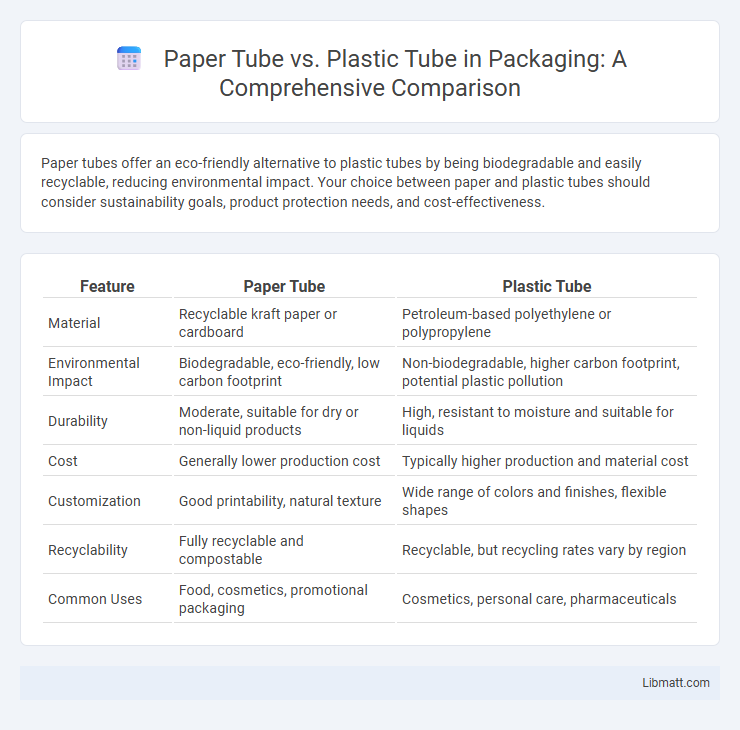Paper tubes offer an eco-friendly alternative to plastic tubes by being biodegradable and easily recyclable, reducing environmental impact. Your choice between paper and plastic tubes should consider sustainability goals, product protection needs, and cost-effectiveness.
Table of Comparison
| Feature | Paper Tube | Plastic Tube |
|---|---|---|
| Material | Recyclable kraft paper or cardboard | Petroleum-based polyethylene or polypropylene |
| Environmental Impact | Biodegradable, eco-friendly, low carbon footprint | Non-biodegradable, higher carbon footprint, potential plastic pollution |
| Durability | Moderate, suitable for dry or non-liquid products | High, resistant to moisture and suitable for liquids |
| Cost | Generally lower production cost | Typically higher production and material cost |
| Customization | Good printability, natural texture | Wide range of colors and finishes, flexible shapes |
| Recyclability | Fully recyclable and compostable | Recyclable, but recycling rates vary by region |
| Common Uses | Food, cosmetics, promotional packaging | Cosmetics, personal care, pharmaceuticals |
Introduction to Paper Tubes and Plastic Tubes
Paper tubes, made from layers of kraft paper or cardboard, offer an eco-friendly alternative to conventional plastic tubes, providing excellent rigidity and lightweight properties suitable for packaging and shipping. Plastic tubes, typically produced from polyethylene or polypropylene, ensure durability, flexibility, and resistance to moisture and chemicals, making them ideal for cosmetics, food, and pharmaceutical industries. Both materials serve distinct purposes based on sustainability goals, product protection, and cost-efficiency requirements.
Material Composition and Manufacturing Process
Paper tubes are composed primarily of recycled paper fibers bonded together through a pulping process and shaped by winding layers around a mandrel, producing a lightweight and biodegradable product. Plastic tubes, typically made from polyethylene or polypropylene, undergo extrusion or injection molding where molten polymers are shaped into a durable, flexible container. Your choice between these tubes should consider environmental impact from paper's renewable sources versus plastic's synthetic durability and manufacturing complexity.
Environmental Impact and Sustainability
Paper tubes offer a significantly lower environmental impact compared to plastic tubes due to their biodegradability and recyclability, reducing landfill waste and pollution. They are often made from renewable resources such as recycled paper, supporting sustainable forestry practices and decreasing reliance on fossil fuels. Plastic tubes, typically derived from petrochemicals, contribute to long-lasting environmental pollution and require more energy-intensive manufacturing processes, making paper tubes a more eco-friendly packaging alternative.
Durability and Strength Comparison
Paper tubes offer moderate durability with resistance to light pressure and are eco-friendly, but they tend to weaken when exposed to moisture or heavy impact. Plastic tubes provide superior strength and durability, offering excellent resistance to water, chemicals, and physical wear, making them ideal for long-term use and harsh environments. For your applications demanding robust protection and extended lifespan, plastic tubes typically outperform paper tubes in maintaining structural integrity.
Cost Analysis: Paper Tube vs Plastic Tube
Paper tubes generally offer a lower production cost due to the use of renewable materials and simpler manufacturing processes compared to plastic tubes, which rely on petroleum-based raw materials and energy-intensive extrusion methods. In terms of lifecycle expenses, paper tubes are more cost-effective due to their recyclability and biodegradability, reducing waste management and environmental compliance costs. Plastic tubes, while durable and resistant to moisture, incur higher disposal and environmental impact costs, which are increasingly factoring into the total cost of ownership for businesses.
Applications and Industry Uses
Paper tubes are widely used in packaging for food, cosmetics, and pharmaceuticals due to their eco-friendly and biodegradable properties, making them ideal for sustainable brands and FMCG industries. Plastic tubes dominate the personal care and household products sectors, offering durability, flexibility, and resistance to moisture, which suits products like toothpaste, creams, and cleaning agents. Both materials find applications in industrial uses, but paper tubes are increasingly preferred for environmentally conscious packaging, while plastic tubes remain essential for their protective and long-lasting qualities.
Customization and Design Flexibility
Paper tubes offer superior customization and design flexibility compared to plastic tubes, allowing for intricate printing, embossing, and a wide variety of shapes and sizes tailored to brand identity. Their sustainable nature encourages creative use of textures and eco-friendly finishes, enhancing product appeal and consumer engagement. Plastic tubes, while durable and moldable, often have limitations in achieving detailed surface customization and eco-conscious design variations.
Consumer Perception and Brand Image
Consumers increasingly favor paper tubes over plastic tubes due to growing eco-consciousness and the desire for sustainable packaging, associating paper with environmental responsibility and brand authenticity. Brands using paper tubes often enhance their image by appealing to green values, which boosts customer loyalty and differentiates them from competitors relying on plastic packaging. Research shows that packaging sustainability directly influences purchase decisions, making paper tubes a strategic choice for brands aiming to improve consumer perception and long-term reputation.
Recycling and End-of-Life Considerations
Paper tubes offer superior recyclability compared to plastic tubes, as they are made from renewable resources and decompose more easily in natural environments. Plastic tubes often require specialized recycling processes and can take hundreds of years to break down, contributing to landfill accumulation and microplastic pollution. Selecting paper tubes aligns with sustainable packaging initiatives by reducing environmental impact through efficient recycling and enhanced biodegradability.
Future Trends in Tube Packaging
Future trends in tube packaging emphasize sustainability and eco-friendly materials, driving a shift from plastic tubes to paper tubes due to their biodegradability and lower carbon footprint. Paper tubes are gaining popularity for cosmetic and food products, driven by consumer demand for recyclable and compostable packaging solutions. Your brand can benefit from adopting paper tubes to align with evolving environmental regulations and enhance market appeal.
Paper tube vs plastic tube Infographic

 libmatt.com
libmatt.com